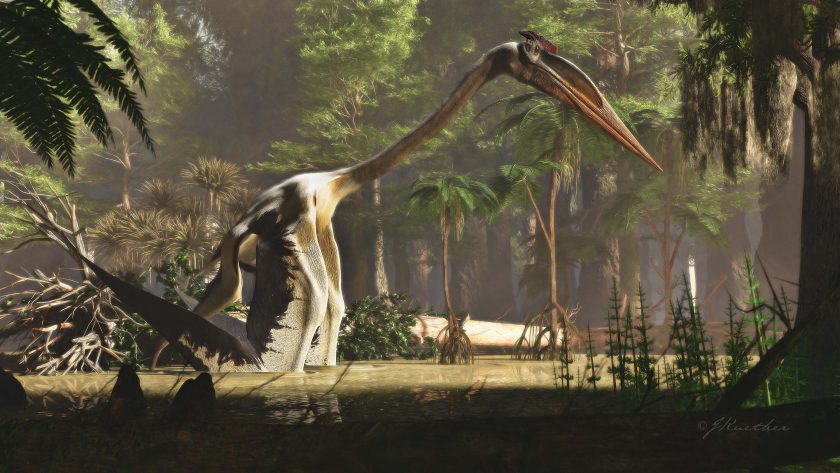Leaping Pterosaur
December 5, 2022

With a wingspan nearing 40 feet, the giant pterosaur Quetzalcoatlus is the largest known animal to take to the sky. But how such a massive animal — known from only a few fossilized bones from West Texas — got airborne has been mostly a matter of speculation.
Some think it rocked forward on its wingtips like a vampire bat. Or that it built up speed by running and flapping like an albatross. Or that it didn’t fly at all.
But according to new research, the mammoth creature probably leaped, jumping at least 8 feet into the air before lifting off by sweeping its wings.
Seen in movies and comic strips and suspended from museum ceilings, the giant “Texas Pterosaur” has been a media staple since it was discovered in 1971 in Big Bend National Park by Douglas Lawson, then a 22-year-old geology graduate student at The University of Texas at Austin.

However, science has not kept up with the pterosaur’s popular image. Aside from Lawson’s early descriptions of the fossils, almost no scientific research has been published based on direct study of the bones.
A new research collection — a monograph made up of an introduction and five studies — helps remedy that, said the co-editor of the collection, Matthew Brown, director of Vertebrate Paleontology Collections at the Jackson School of Geosciences.
“This is the first time that we have had any kind of comprehensive study,” Brown said. “Even though Quetzalcoatlus has been known for 50 years, it has been poorly known.”
The Jackson School’s collections hold all known Quetzalcoatlus fossils. The research involved close study of all confirmed and suspected Quetzalcoatlus bones, along with other pterosaur fossils recovered from Big Bend. This led to the identification of two new pterosaur species — including a new, smaller species of Quetzalcoatlus with an 18-to 20-foot wingspan.
Brian Andres, who began studying Quetzalcoatlus as an undergraduate at the Jackson School and is now a postdoctoral researcher at the University of Sheffield, performed the analysis and named the new species Quetzalcoatlus lawsoni in honor of Lawson.
The two Quetzalcoatlus species both called Big Bend home about 70 million years ago, when the region was an evergreen forest instead of the desert of today. But each led a distinct lifestyle, according to Thomas Lehman, who started his research as a doctoral student at the Jackson School and is now a professor at Texas Tech University.
By examining the geological context in which the fossils were found, Lehman determined that the larger Quetzalcoatlus might have lived like today’s herons, hunting alone in rivers and streams. The smaller species, in contrast, appeared to flock together in lakes — either year-round or seasonally to mate — with at least 30 individuals found at a single fossil site.
Back to the Newsletter